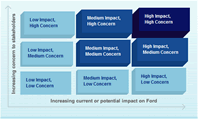Overview of Analysis
What is Materiality?
For the purposes of this report, we consider material information to be that which is of greatest interest to, and which has the potential to affect the perception of, those stakeholders who wish to make informed decisions and judgments about the Company’s commitment to environmental, social and economic progress. Thus, materiality as used in this Sustainability Report does not share the meaning of the concept for the purposes of financial reporting.
How Was the Analysis Conducted?
To identify and prioritize material issues, we significantly updated the analysis done for our 2008/9 Sustainability Report using a three-step process.
Identification of Material Business Issues
We developed a list of more than 500 issues, grouped into 15 topics. The issues were identified by reviewing Ford business documents as well as comments from employees, dealers and our major external stakeholders: customers, communities, suppliers, investors and NGOs. For the Ford analysis, the documents included Ford policies, business strategy and performance tracking tools, and the Annual Report on Form 10-K. To represent stakeholder views, we looked at Ford-specific inputs like summaries of stakeholder engagement sessions as well as documents that represent stakeholder views more broadly, such as the Global Reporting Initiative G3 Guidelines, the Ceres Roadmap to Sustainability and reports from socially responsible and mainstream investors.
Prioritization of the Issues
We noted the frequency with which issues were raised in the source documents and rated each issue as low, moderate or high for current or potential impact on the Company in a three- to five-year timeframe, and degree of concern to stakeholders (by stakeholder group). For each issue, the ratings were averaged separately for Ford and stakeholders (with extra weight assigned to investors and multi-stakeholder inputs, as they are key audiences of our reporting). The issues and their ratings were then plotted on a “materiality matrix.”
We consider the issues in the upper-right sector to be the most material. None of the issues is unimportant; the position of each in the matrix simply represents our understanding of its relative importance to the Company and its stakeholders.
Review of the Analysis
The draft matrix was reviewed internally. It was then reviewed and revised again based on a meeting of a Ceres stakeholder committee that included representatives of environmental and other NGOs, socially responsible investment organizations and a supplier company.
Use of the Analysis
We have used this analysis to identify issues to cover in our reporting and as an input to our sustainability strategy development. This analysis, and the methods for conducting materiality analyses generally, are works in progress. Sustainability issues are not discrete. Rather, they overlap and interconnect in a complex system that is difficult to capture in a list of issues. Analyzing issues by stakeholder group adds depth to our understanding of who is concerned about which issues and why, but in the process of placing them on a two-dimensional matrix, some of that nuance is lost. Finally, an element of subjectivity is inevitable.
We have participated with other companies and organizations in documenting current methods for materiality analysis with the expectation that this will help advance the practice.
Materiality Matrix
Our interactive materiality matrix categorizes issues according to their concern to stakeholders and their current or potential impact on the Company.

